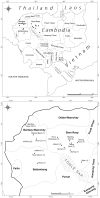Emergence of community-associated methicillin-resistant Staphylococcus aureus associated with pediatric infection in Cambodia
- PMID: 19675670
- PMCID: PMC2721634
- DOI: 10.1371/journal.pone.0006630
Emergence of community-associated methicillin-resistant Staphylococcus aureus associated with pediatric infection in Cambodia
Abstract
Background: The incidence of community-associated methicillin-resistant Staphylococcus aureus (CA-MRSA) infection is rising in the developed world but appears to be rare in developing countries. One explanation for this difference is that resource poor countries lack the diagnostic microbiology facilities necessary to detect the presence of CA-MRSA carriage and infection.
Methodology and principal findings: We developed diagnostic microbiology capabilities at the Angkor Hospital for Children, Siem Reap, western Cambodia in January 2006 and in the same month identified a child with severe community-acquired impetigo caused by CA-MRSA. A study was undertaken to identify and describe additional cases presenting between January 2006 and December 2007. Bacterial isolates underwent molecular characterization using multilocus sequence typing, staphylococcal cassette chromosome mec (SCCmec) typing, and PCR for the presence of the genes encoding Panton-Valentine Leukocidin (PVL). Seventeen children were identified with CA-MRSA infection, of which 11 had skin and soft tissue infection and 6 had invasive disease. The majority of cases were unrelated in time or place. Molecular characterization identified two independent MRSA clones; fifteen isolates were sequence type (ST) 834, SCCmec type IV, PVL gene-negative, and two isolates were ST 121, SCCmec type V, PVL gene-positive.
Conclusions: This represents the first ever report of MRSA in Cambodia, spread of which would pose a significant threat to public health. The finding that cases were mostly unrelated in time or place suggests that these were sporadic infections in persons who were CA-MRSA carriers or contacts of carriers, rather than arising in the context of an outbreak.
Conflict of interest statement
Figures
Similar articles
-
Prevalence and characterisation of Staphylococcus aureus causing community-acquired skin and soft tissue infections on Java and Bali, Indonesia.Trop Med Int Health. 2018 Jan;23(1):34-44. doi: 10.1111/tmi.13000. Epub 2017 Dec 4. Trop Med Int Health. 2018. PMID: 29124834
-
Methicillin-resistant Staphylococcus aureus causes both community-associated and health care-associated infections in children at the Hospital Universitario de Santander.Biomedica. 2014 Apr;34 Suppl 1:163-9. doi: 10.1590/S0120-41572014000500019. Biomedica. 2014. PMID: 24968048
-
Emergence of SCCmec type IV and SCCmec type V methicillin-resistant Staphylococcus aureus containing the Panton-Valentine leukocidin genes in a large academic teaching hospital in central Switzerland: external invaders or persisting circulators?J Clin Microbiol. 2010 Mar;48(3):720-7. doi: 10.1128/JCM.01890-09. Epub 2009 Dec 30. J Clin Microbiol. 2010. PMID: 20042625 Free PMC article.
-
The evolution of Staphylococcus aureus.Infect Genet Evol. 2008 Dec;8(6):747-63. doi: 10.1016/j.meegid.2008.07.007. Epub 2008 Jul 29. Infect Genet Evol. 2008. PMID: 18718557 Review.
-
Community-associated meticillin-resistant Staphylococcus aureus in children in Taiwan, 2000s.Int J Antimicrob Agents. 2011 Jul;38(1):2-8. doi: 10.1016/j.ijantimicag.2011.01.011. Epub 2011 Mar 11. Int J Antimicrob Agents. 2011. PMID: 21397461 Review.
Cited by
-
Bloodstream infection among adults in Phnom Penh, Cambodia: key pathogens and resistance patterns.PLoS One. 2013;8(3):e59775. doi: 10.1371/journal.pone.0059775. Epub 2013 Mar 29. PLoS One. 2013. PMID: 23555777 Free PMC article.
-
Methicillin-Resistant Staphylococcus aureus: Molecular Characterization, Evolution, and Epidemiology.Clin Microbiol Rev. 2018 Sep 12;31(4):e00020-18. doi: 10.1128/CMR.00020-18. Print 2018 Oct. Clin Microbiol Rev. 2018. PMID: 30209034 Free PMC article. Review.
-
Emerging ST121/agr4 community-associated methicillin-resistant Staphylococcus aureus (MRSA) with strong adhesin and cytolytic activities: trigger for MRSA pneumonia and fatal aspiration pneumonia in an influenza-infected elderly.New Microbes New Infect. 2016 May 26;13:17-21. doi: 10.1016/j.nmni.2016.05.011. eCollection 2016 Sep. New Microbes New Infect. 2016. PMID: 27358743 Free PMC article.
-
Comparison of community-onset Staphylococcus argenteus and Staphylococcus aureus sepsis in Thailand: a prospective multicentre observational study.Clin Microbiol Infect. 2016 May;22(5):458.e11-9. doi: 10.1016/j.cmi.2016.01.008. Epub 2016 Jan 22. Clin Microbiol Infect. 2016. PMID: 26806258 Free PMC article.
-
A field guide to pandemic, epidemic and sporadic clones of methicillin-resistant Staphylococcus aureus.PLoS One. 2011 Apr 6;6(4):e17936. doi: 10.1371/journal.pone.0017936. PLoS One. 2011. PMID: 21494333 Free PMC article.
References
-
- Klevens RM, Morrison MA, Nadle J, Petit S, Gershman K, et al. Invasive methicillin-resistant Staphylococcus aureus infections in the United States. JAMA. 2007;298:1763–71. - PubMed
-
- Herold BC, Immergluck LC, Maranan MC, Lauderdale DS, Gaskin RE, et al. Community-acquired methicillin-resistant Staphylococcus aureus in children with no identified predisposing risk. JAMA. 1998;279:593–8. - PubMed
-
- CDC. Four pediatric deaths from community-acquired methicillin-resistant Staphylococcus aureus–Minnesota and North Dakota, 1997–1999. JAMA. 1998;282:1123–5. - PubMed
-
- Adhikari RP, Cook GM, Lamont I, Lang S, Heffernan H, Smith JM. Phenotypic and molecular characterization of community occurring, Western Samoan phage pattern methicillin-resistant Staphylococcus aureus. J Antimicrob Chemother. 2002;50:825–31. - PubMed
Publication types
MeSH terms
Grants and funding
LinkOut - more resources
Full Text Sources
Medical


